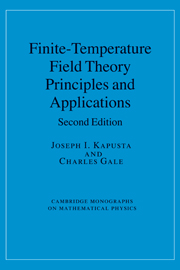Book contents
- Frontmatter
- Contents
- Preface
- 1 Review of quantum statistical mechanics
- 2 Functional integral representation of the partition function
- 3 Interactions and diagrammatic techniques
- 4 Renormalization
- 5 Quantum electrodynamics
- 6 Linear response theory
- 7 Spontaneous symmetry breaking and restoration
- 8 Quantum chromodynamics
- 9 Resummation and hard thermal loops
- 10 Lattice gauge theory
- 11 Dense nuclear matter
- 12 Hot hadronic matter
- 13 Nucleation theory
- 14 Heavy ion collisions
- 15 Weak interactions
- 16 Astrophysics and cosmology
- Conclusion
- Appendix
- Index
Preface
Published online by Cambridge University Press: 04 November 2009
- Frontmatter
- Contents
- Preface
- 1 Review of quantum statistical mechanics
- 2 Functional integral representation of the partition function
- 3 Interactions and diagrammatic techniques
- 4 Renormalization
- 5 Quantum electrodynamics
- 6 Linear response theory
- 7 Spontaneous symmetry breaking and restoration
- 8 Quantum chromodynamics
- 9 Resummation and hard thermal loops
- 10 Lattice gauge theory
- 11 Dense nuclear matter
- 12 Hot hadronic matter
- 13 Nucleation theory
- 14 Heavy ion collisions
- 15 Weak interactions
- 16 Astrophysics and cosmology
- Conclusion
- Appendix
- Index
Summary
What happens when ordinary matter is so greatly compressed that the electrons form a relativistic degenerate gas, as in a white dwarf star? What happens when the matter is compressed even further so that atomic nuclei overlap to form superdense nuclear matter, as in a neutron star? What happens when nuclear matter is heated to such great temperatures that the nucleons and pions melt into quarks and gluons, as in high-energy nuclear collisions? What happened in the spontaneous symmetry breaking of the unified theory of the weak and electromagnetic interactions during the big bang? Questions like these have fascinated us for a long time. The purpose of this book is to develop the fundamental principles and mathematical techniques that enable the formulation of answers to these mind-boggling questions. The study of matter under extreme conditions has blossomed into a field of intense interdisciplinary activity and global extent. The analysis of the collective behavior of interacting relativistic systems spans a rich palette of physical phenomena. One of the ultimate goals of the whole program is to map out the phase diagram of the standard model and its extensions.
This text assumes that the reader has completed graduate level courses in thermal and statistical physics and in relativistic quantum field theory.
- Type
- Chapter
- Information
- Finite-Temperature Field TheoryPrinciples and Applications, pp. xi - xiiPublisher: Cambridge University PressPrint publication year: 2006



